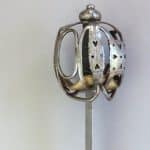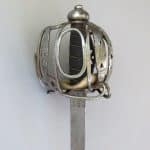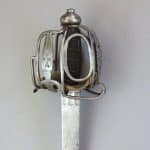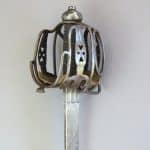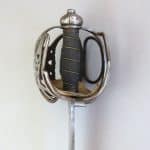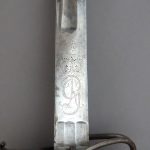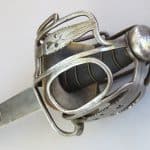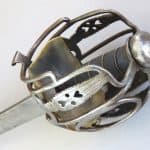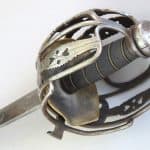
A Mid 18th Century British Dragoon Basket Hilted Sword with a “G R” Cypher on the blade by HARVEY
To enquire about this itemplease click here
Price: £4,250
Ref: 42101943
Item Description
An impressive example of a horseman’s basket hilted back sword made for an Officer, or Trooper, of a North British / Scottish Regiment of Dragoons towards the middle and third quarter of the 18th century. These swords were issued by the Board of Ordnance and were manufactured in the Scottish manner. The type was first issued in the second quarter of the 18th century and used during the Jacobite Rebellion of 1745, Britain’s wars in Europe and the French Indian War in North America and the American Revolutionary War. The blade is of fine quality stamped “HARVEY” and incised with the royal Cypher of King George II or III. The sword is a rare survivor, well preserved and in undamaged condition, as is visible in the photographs.
The fully formed basket is pierced with hearts and circles in the main front and side panel guards which are also finely fretted at the edges with chevrons and merlons. One of the more usual frontal guard plates has been replaced in the hilt design with an oval ring in the “horseman” fashion.
The arms of the guard are forged onto a circle of iron into which the base of the bun shaped pommel sits. The pronounced button is integral with the pommel and not of separate manufacture. The original spirally fluted grip is of hardwood with a shagreen cover, and retains its twisted brass wire binding. The hilt retains its leather buff coloured liner.
The imposing fine quality tapering blade is just under 36 inches long (just over 91 cm) and made by HARVEY of Birmingham, a noted contractor to the British Board of Ordnance at the time, and typical of this heavy blade type. The blade is intended mainly for striking downwards at opposing infantry soldiers and cavalry with great force and reach.
The blade has a thick spine and is double edged for the last 13 inches (33 cm) towards the point after the fuller terminates and the back edge has been sharpened to the tip. It has a short ricasso from which three conjoined broad fullers extend along the blade for an inch from the hilt (2.5 cm). A broad fuller commences 5 inches (13 cm) from the blade and tapers to the tip. From the same place a narrower deeper fuller runs underneath the spine on both sides until the blade becomes double edged. The space between the two sets of fullers is engraved on both sides with the “G R” Cypher with crown above, and “HARVEY” beneath.
Although many swords of this type survive with blades of shorter length, the majority of these have been shortened during their working lives. This blade retains its original length.
Overall the sword is in fine condition. For a further example of this sword type see Cyril Mazansky, British Basket-Hilted Swords, Boydell Press / Royal Armouries, 2005, plate F1e page 97, for a sword in the National Museums of Scotland, collection reference LA33.




